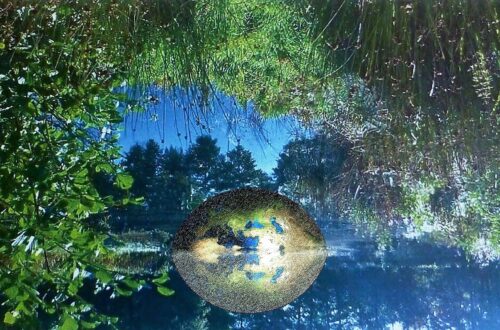
Do We Love the World Enough to Save It?
Let me ask you a question before we begin. When you look out at the world around you, what do you see? How do you relate to it?
How Do You View the World?
If you view the world as dead stupid matter that is only here for us to use and exploit, then you would believe you have no real intimate relation to it.
However, if you view the world not as dead stupid matter, but a reflection of yourself, then you and the outer world are not separate, but intimately one and the same.
How we answer those questions may very well determine our future on this planet.
If you accept the first answer, then you subscribe to the modern worldview of reality. If you accept the second answer, then you hold the integral worldview of reality.
We are currently in a devastating heat wave that is setting temperature records around the world. It’s killing thousands of people and causing fires in places that don’t normally have fires of this magnitude.
More and more we are suffering the consequences of a flawed worldview, yet most people don’t seem moved to demand we fundamentally restructure our economy, and curtail our use of fossil fuels to save our existence on this planet.
If we see the planet as made up of dead matter, it’s very unlikely we would care enough to save it. However, if we see the world as us, then we most certainly will want to preserve our stay here.
“We Only Conserve What We Love”
The Senegalese forestry engineer, Baba Dioum put it this way,
“In the end we will conserve only what we love, we will love only what we understand, and we will understand only what we are taught.”
So, clearly if we want to save this planet and our existence on it, we have to feel more connected to it. We can’t just think of it as an “it” but instead as an integral part of who we are.
But why don’t we feel connected to the planet and see it as a reflection of ourselves?
The Planet Dead Stuff Goes Back to Descartes
We can trace the cause back to the father of modern philosophy, Rene Descartes, who created a method to see if he could discover any absolute truths that nobody could question. He discovered four of these truths, two of which state that we are non-material minds existing in material bodies and a world, and the two (non-material and material) are completely separate and distinct from each other.
So therein lies the crux of the problem. We are isolated beings living in a disconnected alien world.
This led to an interesting history of philosophy where slowly all of Descartes absolute truths were debunked, leading to the ultimate skepticism of the empiricist philosopher, David Hume. He concluded that we can’t know anything absolutely certain about the world, thus he thought, ending philosophy as a discipline.
Kant’s Copernican Revolution in Philosophy Changes Everything
This created a real crisis in philosophy. It sent the German philosopher, Immanuel Kant, into a deep depression. He couldn’t find any flaws in Hume’s argument.
He realized the old model of the mind passively studying and discovering the truths of a fixed world was dead. After giving this much thought, Kant finally came to the realization that modern philosophy’s whole approach to the search for knowledge had been misguided, and needed a complete overhaul. The big change Kant instituted came to be known as The Copernican Revolution in Philosophy.
It was called this because prior to Copernicus, people believed the sun orbited the earth. Copernicus changed that, establishing that it was the earth that orbited the sun.
In the same way, philosophers before Kant believed that in order to acquire knowledge, the mind had to orbit the world to discern its truths. The world was this fixed object that the mind had to study to acquire its truths.
In other words, the world was primary and the mind, secondary. The world held all the truths, and the mind had to discover them.
This led to Hume’s skepticism because he showed that following this approach there were no truths to be discovered.

Photo by Alan Godfrey on Unsplash
Instead, Kant said, rather than the mind circling and mirroring the world, the world circled and mirrored the mind. Here the mind is primary and the world is secondary. Rather than the mind passively acquiring the truths about the world, the world actually circled the mind, meaning we actively construct the world based on the structures and prejudices of our mind. In short, the world is not just something our mind passively mirrors, but instead, something our mind actively constructs.
I should point out here that Kant was not an idealist. He did believe there was a world out there beyond its appearances. For Kant we could only know the world as our mind created it, but we could never know the world as it is in itself.
How Our Minds Create Reality
An example of our mind creating the world appeared in my article entitled What is Reality. I compared a dragonfly’s perception of a lake with its twelve photo receptors, to our perception of the same lake with our four photo receptors. Clearly, we would not see the same lake. We would each see the lake our visual apparatus allowed us to see. The lake is not something out there that is fixed that our minds just mirror back to us.
You might counter this by saying, okay, dragonflies and other species might see the lake differently because they are constructed differently than we are, but certainly, humans, with the same visual apparatus would see the same lake. Yes, and no.
Another Example Using Humans This Time
Let’s take another example. Suppose a young man has a date to meet his beloved. As he walks to meet her at her house, he is in a very good mood. He loves listening to the birds chirping, children playing, and dogs barking. He even looks at some homeless people and feels some compassion for their plight, and gives them some money.
When he reaches his girlfriend’s house he sees a note on the door, claiming that some emergency has arisen and she won’t be able to meet him after all. Now he is in a foul mood.

Photo by Zulnureen Shariff on Unsplash
As he takes the same path home, all of a sudden the birds chirping, the children playing, and the dogs barking annoy him to no end. He wonders why people can’t keep better control of their kids and animals. Now when he looks at those same homeless people, he feels disgust and wonders why the police allow such people to hang out in public spaces.
From this example we see, there is no fixed world he is responding to. Instead, he is creating the outside world by his state of consciousness. When he is in a good mood, it’s all wonderful and beautiful, yet when he returns home in a bad mood, it all sucks.
Edmund Husserl Says Consciousness is Intentional
The German phenomenologist, Edmund Husserl agreed with Kant in realizing the modern world view of a passive mind mirroring a fixed world was flawed.
Husserl believed consciousness is intentional. Rather than passively reflecting the world, the mind imposes itself on the world.
In short, our mind intends the world. In our everyday life, our mind is bombarded with so much stimuli, we can’t possibly process it all, so we choose which stimuli to focus on and which to ignore. That choice depends on our intention at the time.
If we are on a long car trip and are hungry because we haven’t eaten anything in a while, then as we drive through a town we are going to focus on finding a restaurant, ignoring everything else. If someone asked what we thought of a prominent statue we had driven by, it is likely we didn’t see it. We weren’t focused on it.
Or, if we are low on gas and driving through the same town, we would likely not notice any restaurants since we are focused solely on locating a gas station.
In short, how we view the world is conditioned by our intentionality.
So, if our view of the world is structured by our mind, then in order to find out anything about the world, we would first have to discover something about how and why our mind structures the world the way it does. The way we view the world tells us more about ourselves than it does about the world.
The question then becomes where did I learn this modern view of the world? Most likely that is what I was taught growing up.
Remember the part of the earlier quote that said,
“We will only understand what we have been taught.”
How To Uncover Our Conditioning to Reach Pure Consciousness
In order to see through this conditioning, Husserl says we need to perform what he calls a phenomenological reduction whereby we bracket off all our beliefs, theories, attitudes and preconceptions about the world and ourselves to examine them.
In other words, can I apprehend the world directly without any of these unconscious prejudices or pre-conceived notions? Am I able to unearth all my unconscious biases so I can view the world from a purely objective standpoint?
Husserl is trying to do something revolutionary here. We have gone from the absolute truths the modern world claimed to believe in, to the relativity of the post-modern world that had debunked all those truths. So, what’s left?
Husserl is attempting to come up with a method whereby we can once again have a purely objective experience of the world.
The Transcendental Ego
Husserl is trying to bring science into the study of consciousness to reach a pure, unbiased state of consciousness. We do this in a kind of meditation where we can peel away the layers of our conditioning. He believes behind all this conditioning is the Transcendental Ego.
Our normal ego is focused only on our individual self, but the transcendental ego is the higher part of ourselves that connects us to the cosmos. In short, it is our “God-Self” or pure consciousness. It is the atman to the Brahman for those who understand Hinduism.

Photo by Jeremy Bezanger on Unsplash
So, let’s examine our view of, say, some homeless people on the street, and observe our reaction to them. First, we bracket off those feelings, thoughts and attitudes we have and ask, why we have them and where they came from. Then, we can gradually peel away the layers of our biases, to reach a pure direct experience of the homeless people minus all that mental baggage we normally carry with us.
When we do this, there ends up being no separation between ourselves and the homeless. What separated us before were our unconscious thoughts, feelings and prejudices about them. When we are able to rid ourselves of those, we realize we are them.
The point here is to observe all this in yourself as you observe the world. See how your moods, feelings, attitudes, and thoughts affect your appraisal of the world.
To Love and Save the World We Must Feel Connected To It
The point is not to see the world as good or bad, but to look at ourselves and see how our conditioning has influenced our view of the world. Our view of the world often tells us more about ourselves than it does about the world. The world ends up being a reflection of who we are. We are intimately connected to it. It is us whether we realize it or not.
It is our inability to do this, that is leading to our destruction. We think we are separate and just passively observing this climate disaster unfold, when in reality we are active participants in its destruction.
Rather than seeing ourselves as passive recipients of stimuli from a separate world, we have to take responsibility for those views and figure out where they are coming from and why we have them. It is only when we feel we are intimately connected to the world, that we will love it enough to save it.
As Baba Dioum says,
“In the end, we only conserve what we love, and we only love what we understand.”
To learn more: Click this link: The Magical Universe.
Cover Photo by Elias Domsch on Unsplash




